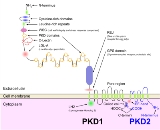
Polycystic kidney disease 2
Encyclopedia
Polycystin-2 is a protein
that in humans is encoded by the PKD2 gene
.
with TRPC1
, PKD1
and TNNI3
.
Protein
Proteins are biochemical compounds consisting of one or more polypeptides typically folded into a globular or fibrous form, facilitating a biological function. A polypeptide is a single linear polymer chain of amino acids bonded together by peptide bonds between the carboxyl and amino groups of...
that in humans is encoded by the PKD2 gene
Gene
A gene is a molecular unit of heredity of a living organism. It is a name given to some stretches of DNA and RNA that code for a type of protein or for an RNA chain that has a function in the organism. Living beings depend on genes, as they specify all proteins and functional RNA chains...
.
Interactions
Polycystic kidney disease 2 has been shown to interactProtein-protein interaction
Protein–protein interactions occur when two or more proteins bind together, often to carry out their biological function. Many of the most important molecular processes in the cell such as DNA replication are carried out by large molecular machines that are built from a large number of protein...
with TRPC1
TRPC1
Transient receptor potential channel 1 is a protein that in humans is encoded by the TRPC1 gene.- Function :TRPC1 is an ion channel located on the plasma membrane of numerous human and animal cell types. It is a nonspecific cation channel, which means that both sodium and calcium ions can pass...
, PKD1
PKD1
Polycystin-1 is a protein that in humans is encoded by the PKD1 gene.-Gene product:-Function:Polycystin-1 is a glycoprotein which contains a large N-terminal extracellular region, multiple transmembrane domains and a cytoplasmic C-tail...
and TNNI3
TNNI3
Troponin I, cardiac muscle is a protein that in humans is encoded by the TNNI3 gene.-Interactions:TNNI3 has been shown to interact with PKD2L1, Troponin C type 1 and Polycystic kidney disease 2.-Further reading:- External links :*...
.

